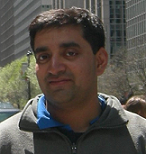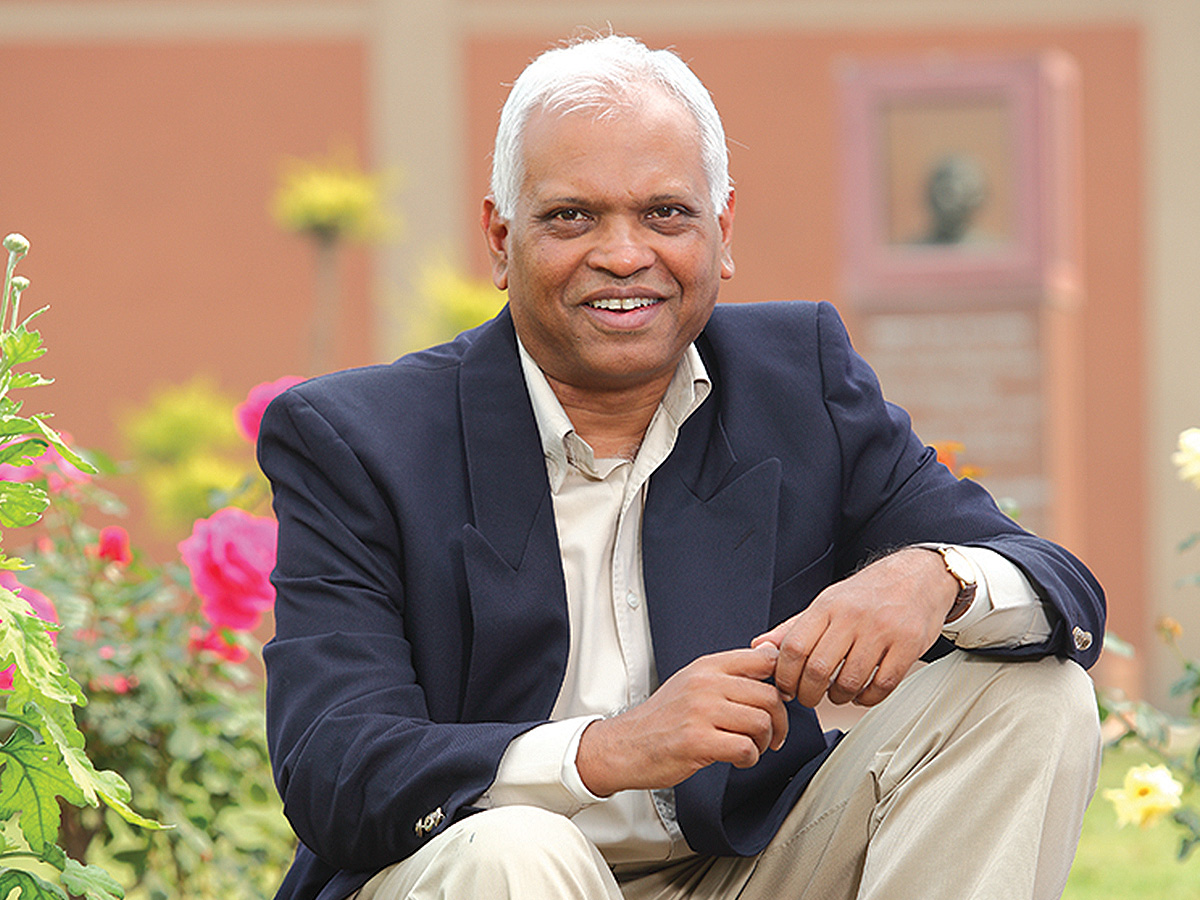

Siva Athreya
ICTS-TIFR, Bengaluru, India
Interplay of vertex and edge dynamics for dense random graph
Monday, October 28, 2024, 11:00 -- 11:30
We consider a dense random graph in which the vertices can hold opinion $0$ or $1$ and the edges can be closed or open. The vertices update their opinion at rate $\eta$ times the number of incident open edges, and do so by adopting the opinion of the vertex at the other end. The edges update their status at rate $\rho$, and do so by switching between closed and open with a probability that depends on their status and on whether the vertices at their ends are concordant or discordant. We understand $n \rightarrow \infty$ limit of this co-evolution and describe the limiting evolution.
This is joint work with Frank den Hollander and Adrian Roellin.

Antar Bandyopadhyay
Indian Statistical Institute, Delhi, India
Interacting Urn Schemes: a simple and solvable model of Self-Organized Criticality (SOC)
Sunday, October 27, 2024, 3:15 -- 15:45
In this talk, we will introduce a novel model of interactive urn schemes with the goal of obtaining a limiting distribution, which may be considered as a simple and solvable example of Self-Organized Criticality (SOC). The interactions will be defined via a network (possibly infinite). We will show that limit exists under fairly general condition if the underline graph has a specific directed structure. We will further indicate how limits can be proved for more general structure including undirected graphs.
This is a joint work with Deborshi Das.

Vivek Borkar
Indian Institute of Technology, Bombay, Mumbai, India
Markov selection for degenerate diffusions (A half-open problem?)
Sunday, October 27, 2024, 10:40 -- 11:10
The talk will describe a more principled approach to selecting a family of Markov measures for an ill posed martingale problem associated with degenerate diffusions and describe the successes and limitations of this approach.
Joint work with K. Suresh Kumar and Anugu Sumith Reddy.

Arijit Chakrabarty
Indian Statistical Institute, Kolkata, India
Clustering of rare events
Monday, October 28, 2024, 10:30 -- 11:00
This talk is on understanding how the rare events of deviation of sample mean from population mean cluster for data coming from a stationary process whose marginal distribution has all exponential moments finite. Conditional on the event that the average of the first n observations exceeds the population mean by a prefixed threshold, we study the asymptotic distribution of the length of time for which this deviation persists, as n goes to infinity. It turns out that the answer depends on the memory of the stationary process. In the short memory regime, the asymptotic conditional distribution of the persistence time is a law on the set of natural numbers, whereas in the long memory regime, the persistence time goes almost surely to infinity. In the latter regime, the asymptotic conditional law under an appropriate scaling is studied.
This is a joint work with Gennady Samorodnitsky.
Apoorva Khare
Indian Institute of Science, Bangalore, India
Probability inequalities over left-invariant metric semigroups
Monday, October 28, 2024, 10:00 -- 10:30
We explore how a classical stochastic inequality named after Hoffmann-Jorgensen extends beyond the Banach space setting. This inequality can be stated using only a binary associative operation and a distance function. Thus, we present a generalization that (i) holds in a very primitive mathematical setting: left-invariant metric monoids. In particular, our version holds over every Lie group, in addition to all Banach spaces. The result moreover (ii) strictly strengthens prior versions (even for real variables), and (iii) unifies previously disparate Banach space variants in the literature. We will also see some consequences.

Krishanu Maulik
Indian Statistical Institute, Kolkata, India
Asymmetric Elephant Random Walk
Sunday, October 27, 2024, 4:15 -- 16:45
Elephant random walk has become a subject of great interest since it was introduced by Schutz and Trimper. It generalizes the simple symmetric random walk, where a step is chosen uniformly from the entire past history of the walk and then the new move is made by repeating the step with certain probability or flipping it with complementary probability. We introduce an asymmetric version of it, where the flip probabilities depend on the sign of the chosen step. By considering a representation in terms of two color urns, we provide SLLN and fluctuations around the SLLN limit. The fluctuations show a phase transition from diffusive to superdiffusive behavior depending on the flip probabilities. The limiting distribution of the fluctuations are Gaussian in subcritical and critical cases. We also provide Berry-Esseen type bounds for the rates of convergence in these two cases.
This is a joint work with Aritra Majumdar.

Ravi Mazumdar
University of Waterloo, Waterloo, Canada
On Large Loss Models with Splittable Jobs
Sunday, October 27, 2024, 11:10 -- 11:40
In this talk I will introduce a new class of models that are of relevance in the context of
parallelization in multiserver systems. In particular we consider adaptive multi-rate multi-server jobs where each job can be run on a variable number of servers up to a maximum number. This
leads to a new class of loss moders with a variable number of servers.
The job allocation policy follows a greedy approach, meaning that when an arriving job en-
counters $j$ idle servers, it occupies $i = min(d, j)$ servers, with a mean holding time of $ \tfrac{1}{i}$ (assuming
no overhead due to job splitting). Given a flow of jobs with rate $ n \lambda$, we analyze the behavior of
the system for large $n$. Focusing on the occupation vector, which describes the number of jobs split
across $i$ servers for $ i = 1, \dotsc , d$, we demonstrate that as $n$ tends to infinity, a state space collapse
occurs, where all jobs are distributed over $d$ servers. Consequently, the system asymptotically
behaves like a blocking system, in which jobs are either split over $d$ servers or rejected.
This model is difficult to analyze as there is no monotonicity to obtain any sample-path coupling
argument. So instead we use an idea of coupling the generator of a mean-field fluid limit to
underlying Markov process related to the server occupancy and then exploit Stein’s technique.
Joint work with S. Ghanbarian (Waterloo), F. Guillemin (Orange), and A. Mukhopadhyay
(Warwick).

Moumanti Podder
Indian Institute of Science Education and Research, (IISER), Pune, India
A model of social learning on rooted regular trees
Sunday, October 27, 2024, 10:10 -- 10:40
Let $\mathbb{T}_{m}$ be the rooted regular tree in which each vertex has $m$ children. An agent is stationed at each vertex of $\mathbb{T}_{m}$, and is allowed, at any point in time, to select one of two available technologies: $B$ and $R$. Let $C_{t}(v)$ denote the technology chosen by the agent at vertex $v$ at time-step $t$, for $t \in \mathbb{N}_{0}$. During the epoch $t$, the agent at $v$ performs an experiment that results in success with probability $p_{B}$ if $C_{t}(v)=B$, and with probability $p_{R}$ if $C_{t}(v)=R$. Letting $v_{1}, v_{2}, \ldots, v_{m}$ denote the children of $v$, the agent at $v$ updates their technology to $C_{t+1}(v)=B$ if the number of successes among all $v_{j}$, $1 \leqslant j \leqslant m$, with $C_{t}(v_{j})=B$, strictly exceeds the number of successes among all $v_{j}$, $1 \leqslant j \leqslant m$, with $C_{t}(v_{j})=R$. If these two numbers are equal, the agent at $v$ sets $C_{t+1}(v)=B$ with probability $1/2$. In all other cases, $C_{t+1}(v)=R$. We study the limit, as $t \rightarrow \infty$, of the process $\{C_{t}(v): v \in \mathbb{T}_{m}\}$, when \begin{align*} (1) \qquad & p_{B}, p_{R} \in [0,1] \text{ and } m=2; \\ (2) \qquad & p_{B}=p_{R}=p \text{ and } m \text{ is an arbitrary positive integer with } m \geqslant 3; \\ (3) \qquad & p_{B}=1, p_{R} \in [0,1) \text{ and } m=3. \end{align*} Phase transition phenomena are shown to take place in the latter two scenarios. This work can also be interpreted as a model for the diffusion of technologies throughout a population of agents.

Parthanil Roy
Indian Statistical Institute, Bangalore, India
Phase Transition for Elephant Random Walks with Two Memory Channels
Sunday, October 27, 2024, 4:45 -- 17:15
Random processes with strong memory and/or self-excitation arise naturally in various disciplines including physics, economics, biology, geology, etc. Memory can be multifaceted and can arise due to interactions of more than one underlying phenomena. Many of these processes exhibit superdiffusive growth due to the effect of self-excitation. A class of one-dimensional, discrete-time such models called “random walk with m memory channels” was introduced and discussed in a recent paper on statistical physics by Saha (2022). In these models, the information of m independently chosen steps from the walker’s entire history is needed to decide the future step. The aforementioned work carried out heuristic calculations of variance, and conjectured phase transitions from diffusive to superdiffusive and from superdiffusive to ballistic regimes in the m=2 case. We have proved these conjectures rigorously (with mild corrections), and discovered a new regime beyond the predicted ones. These results will be presented along with several open problems.
This talk is based on a joint work with Krishanu Maulik and Tamojit Sadhukhan.

Kumarjit Saha
Ashoka University, Sonepat, India
Convergence of the dynamical discrete web to dynamical Brownian web
Sunday, October 27, 2024, 12:40 -- 13:10
In this talk we will introduce a Polish space to study process level convergence to the dynamical Brownian web (DyBW). We will further show that w.r.t. the introduced topology, as a diffusively scaled process sequence of dynamical discrete web converges to the DyBW. This is the first process level convergence result to the DyBW.
This is a joint work with Krishnamurthy Ravishankar.

Anish Sarkar
Indian Statistical Institute, Delhi, India
First Collision time of three random walks
Sunday, October 27, 2024, 2:45 -- 15:15
In this talk, we discuss the finiteness of the expected value of the first collision time of three random walks and obtain an upper bound to the expected value if terms of the starting positions of the walks. The result is expected to simplify the computations of the estimates of the number of paths for convergence of the family of such walks to the corresponding limit.
This is a joint work with Maruf Alam Tarafar.

Arunava Sen
Indian Statistical Institute, Delhi, India
Teacher Redistribution in Public Schools
Sunday, October 27, 2024, 12:10 -- 12:40
The Right to Free and Compulsory Education Act (2009) (RTE) of the Government of
India prescribes teacher-student ratios for state-run schools.
One method advocated by the Act to achieve its goals is the redeployment of teachers from
surplus to deficit schools. We consider a model where teachers can either remain in their initially
assigned schools or be transferred to a deficit school in their acceptable set. Transfers cannot turn
a surplus school into a deficit school and a deficit school cannot be made a surplus school. The
planner's objective is specified in terms of the post-transfer deficit vector that can be achieved.
We formulate the problem as a network-flow problem. We show that there exists a transfer
policy that generates a post-transfer deficit vector that Lorenz dominates all achievable post-
transfer deficit vectors. We also show that the Lorenz-dominant post-transfer deficit vector can
be achieved as the outcome of a strategy-proof mechanism.
Joint work with Debasis Mishra, Soumendu
Sarkar, Jay Sethuraman and Sonal Yadav